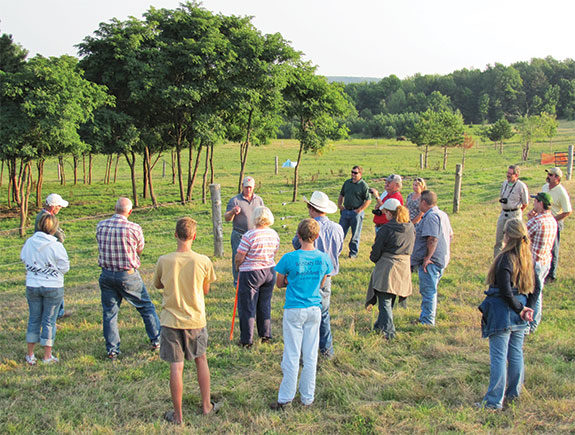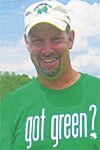You might ask what prompted this bucolic scene during the summer of 2012.
Believe it or not, folks came out to learn more about this new grazing concept called silvopasture, which integrates trees with forage and livestock production.
Silvopasturing is an agroforestry system used to produce both livestock and forest products on the same land over an extended period of time. It can be thought of as a hybrid between well-managed pastures and well-managed woodlands.
The term implies skilled management, beneficial outcomes, deliberate attention to multiple objectives and symbiosis between grazing animals and their wooded environment.
A silvopasture system can be developed from one of two perspectives: enriching open pastures with trees or modifying natural forests and plantations through thinning to develop forage plants in the understory.
The successful integration of pastures and woods – that is, grazing with silviculture – requires an experienced eye and knowledge of both disciplines.

The idea of managing pastures with mixed conifers and hardwoods intrigued Glenn Trush, who with his family operates Woodwatch Farm, a 300-acre property and home to a growing Highland cattle herd.
With help from the Madison County Planning Department in making farm maps, he introduced everyone to the farm goals and practices in place so far and showed the group the history of the farm and how the open land is being reverted back to forest.
“I had heard of this practice, and since it fits with our long-term goals, it was the right time to host a meeting and learn more before we progress in our grazing system plans and get opinions from other farmers on how we’re doing so far,” said Glenn.
To help farmers, novice and experienced, understand the considerations and nuances of this agroforestry practice, the evening featured Schuyler County’s Agriculture and Natural Resources Educator from Cornell Cooperative Extension and fellow grass farmer 
Brett Chedzoy, who led the pasture walk around the cattle and trees.
“Tonight you are part of an inaugural group of producers striving to go from concept to implementation.
It’s a long-term project that requires skilled management because it’s relatively easy to repair decisions made on grazing lands, whereas forestry decisions can take decades to fix,” said the agroforestry practitioner.
He discussed the opportunities, requirements and keys to making this system work.
Topics teased out from the group included animal stocking rate, cattle impact on tree roots, thinning options, using areas for out-wintering and summer grazing, which tree species are compatible for silvopasture and the economics of bringing the pasture into the woods.
As the complementary cattle grazed in a nearby paddock, conversations surfaced about animal behavior, watering and fencing considerations and forage establishment using frost seeding, sowing annuals or rolling out hay bales throughout the ongoing savannah.
The setting sun and howling coyotes focused folks away from cattle, pasture and trees and on to networking intertwined with making ice-cream sundaes.
“This evening gave us a lot to think about for our farm and was well worth the trip,” said Frank and Cori Drobnica from Coal Hill Highlands in Taberg, New York. “We appreciate the Trush family for opening up their farm so we can go home inspired to think differently about land management.”
The evening was supported by The Madison County Soil and Water Conservation District, The Upper Susquehanna Coalition, The NYS AEM Program, The Finger Lakes-Lake Ontario Watershed Protection Alliance, Schuyler County CCE and hosts Glenn, April, Isaac and Phoebe Trush from Woodwatch Farm. FG
For more information on silvopasture click here; here; click here ; and here.
PHOTOS
Pasture walk around the cattle and trees. Photos courtesy of Troy Bishopp.









